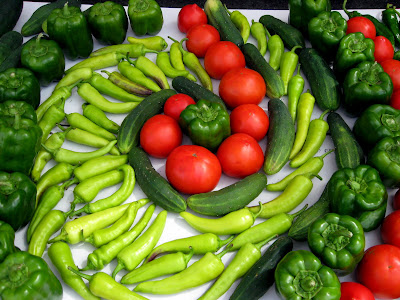
When I was growing up in Walworth County the fair signaled the end of summer. We went to the fair everyday, ate burgers at Loomers stand, cream puffs and sweet corn from other tents, rode the Tilt-a-Whirl a couple dozen times, and after the last day (Labor Day) we went back to school.
All summer I had 4-H classes in various subjects, child care, art, sewing (I never bonded with that one) and foods and nutrition. We took field trips to places like the Nestle factory in Burlington, where we got to inhale chocolate fumes and watch chocolate chips like sparkling black diamonds roll off the assembly line. We learned to comparison shop. We learned how to set a table. We learned the rudiments of nutrition in a state that considered butter a basic food group. But the most fun was meeting at neighbors' houses to make muffins, cakes, cookies and other sinfully delicious foods. We even planned a whole meal via a kid committee, and managed to get it all done at the same time. I loved it. But not as much as I loved getting all my entries ready for the fair. The day before entries were due there'd be a baking marathon at our place. Sometimes all the angelfood cakes, oatmeal cookies and fresh fruit centerpieces were created and packaged without a hitch. Other times there were disasters (dreaded tunnels in the muffins, or broken cookies). But to me it was worth it. I was a glutton for fair ribbons.
Looking at this 4-H photo from a foods class in 1962, I am reminded how styles change. I didn't dress up for the class; I used to actually wear dresses and aprons to cook. It startles me to see it now, considering I only wear dresses to weddings and funerals these days, and I haven't donned an apron in decades. I just try not to think about those dorky glasses.
Anyway, here are two 4-H recipes from 1962, written on stained index cards in my baby handwriting. That salad actually was sort of good (a way to get kids to eat fresh veggies), but not as tempting as the cookies. All that sugar and fat made for blue ribbon cookies.
Sunshine Salad
1 package lemon Jello
1 1/2 cups water (part juice from pineapple)
1/2 cup finely diced celery
1/2 cup shredded raw carrot
1 cup crushed canned pineapple, drained (reserve juice)
1. Put the lemon Jello in a mixing bowl.
2. Drain the juice from pineapple and add water to make 1 1/2 cups liquid
3. Bring the liquid to a boil and pour over the Jello.
4. Stir the Jello until dissolved. Let mixture cool in the icebox until somewhat thick.
5. Prepare the vegetables.
6. Add the vegetables and pineapple to the cooled Jello. Pour into a fancy mold.
7. When firmly set, unmold on a bed of lettuce. We used to top with a dollop of mayonnaise.
Amish Sugar Cookies
1 cup granulated sugar
1 cup powdered sugar
1 cup buttter, softened
1 cup corn oil
2 eggs
4 1/2 cups flour
1 teaspoon vanilla
1 teaspoon baking soda
1 teaspoon salt
1 teaspoon cream of tartar
Beat the sugars, butter and oil together well. Beat in the eggs. Sift together the dry ingredients and stir into the creamed mixture. Roll the batter into balls the size of a walnut, and press flat with the bottom of a drinking glass dipped in sugar. Bake at 350 degrees for 15-20 minutes. Cool on a wire rack. These end up being crisp, which I prefer over chewy cookies.
Enjoy!

















